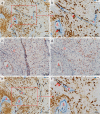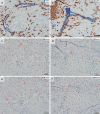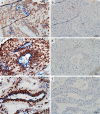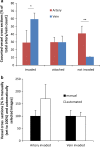Extravillous trophoblasts invade more than uterine arteries: evidence for the invasion of uterine veins
- PMID: 27774579
- PMCID: PMC5344955
- DOI: 10.1007/s00418-016-1509-5
Extravillous trophoblasts invade more than uterine arteries: evidence for the invasion of uterine veins
Abstract
During the first trimester of pregnancy, extravillous trophoblasts (EVTs) invade into the decidual interstitium to the first third of the myometrium, thereby anchoring the placenta to the uterus. They also follow the endovascular and endoglandular route of invasion; plug, line and remodel spiral arteries, thus being responsible for the establishment of hemotrophic nutrition with the beginning of the second trimester and invade and open uterine glands toward the intervillous space for a histiotrophic nutrition during the first trimester. The aim of this study was to provide proof that uterine veins are invaded by EVTs similar to uterine arteries and glands in first trimester of pregnancy. Therefore, serial sections from in situ first trimester placenta were immuno-single- and immuno-double-stained to distinguish in a first step between arteries and veins and secondly between invaded and non-invaded vessels. Subsequently, invasion of EVTs into uterine vessels was quantified. Our data show that uterine veins are significantly more invaded by EVTs than uterine arteries (29.2 ± 15.7 %) during early pregnancy. Counted vessel cross sections revealed significantly higher EVT invasion into veins (59.5 ± 7.9 %) compared to arteries (29.2 ± 15.7 %). In the lumen of veins, single EVTs were repeatedly found, beside detached glandular epithelial cells or syncytial fragments. This study allows the expansion of our hitherto postulated concept of EVT invasion during first trimester of pregnancy. We suggest that invasion of EVTs into uterine veins is responsible the draining of waste and blood plasma from the intervillous space during the first trimester of pregnancy.
Keywords: Endoglandular trophoblasts; Endovascular trophoblasts; Extravillous trophoblasts; Invasion; Placenta; Uterine veins.
Conflict of interest statement
No competing financial interests exist.
Figures








Similar articles
-
Extravillous trophoblast invasion of venous as well as lymphatic vessels is altered in idiopathic, recurrent, spontaneous abortions.Hum Reprod. 2017 Jun 1;32(6):1208-1217. doi: 10.1093/humrep/dex058. Hum Reprod. 2017. PMID: 28369440
-
Endoglandular trophoblast, an alternative route of trophoblast invasion? Analysis with novel confrontation co-culture models.Hum Reprod. 2010 May;25(5):1127-36. doi: 10.1093/humrep/deq035. Epub 2010 Feb 22. Hum Reprod. 2010. PMID: 20176592
-
Evidence from the very beginning: endoglandular trophoblasts penetrate and replace uterine glands in situ and in vitro.Hum Reprod. 2015 Dec;30(12):2747-57. doi: 10.1093/humrep/dev266. Epub 2015 Oct 22. Hum Reprod. 2015. PMID: 26493408 Free PMC article.
-
Human trophoblast invasion: new and unexpected routes and functions.Histochem Cell Biol. 2018 Oct;150(4):361-370. doi: 10.1007/s00418-018-1699-0. Epub 2018 Jul 26. Histochem Cell Biol. 2018. PMID: 30046889 Free PMC article. Review.
-
Trophoblast retrieval and isolation from the cervix: origins of cervical trophoblasts and their potential value for risk assessment of ongoing pregnancies.Hum Reprod Update. 2018 Jul 1;24(4):484-496. doi: 10.1093/humupd/dmy008. Hum Reprod Update. 2018. PMID: 29608700 Free PMC article. Review.
Cited by
-
Examination of FERMT1 expression in placental chorionic villi and its role in HTR8-SVneo cell invasion.Histochem Cell Biol. 2021 Jun;155(6):669-681. doi: 10.1007/s00418-021-01977-y. Epub 2021 Mar 8. Histochem Cell Biol. 2021. PMID: 33683437
-
The Number of Circulating Fetal Extravillous Trophoblasts Varies from Gestational Week 6 to 20.Reprod Sci. 2020 Dec;27(12):2170-2174. doi: 10.1007/s43032-020-00243-1. Epub 2020 Jun 29. Reprod Sci. 2020. PMID: 32602048 Free PMC article.
-
Palmitic Acid Impedes Extravillous Trophoblast Activity by Increasing MRP1 Expression and Function.Biomolecules. 2022 Aug 22;12(8):1162. doi: 10.3390/biom12081162. Biomolecules. 2022. Retraction in: Biomolecules. 2024 Apr 08;14(4):453. doi: 10.3390/biom14040453. PMID: 36009056 Free PMC article. Retracted.
-
In focus in HCB.Histochem Cell Biol. 2017 Mar;147(3):303-305. doi: 10.1007/s00418-017-1541-0. Epub 2017 Mar 1. Histochem Cell Biol. 2017. PMID: 28247029 No abstract available.
-
Oncostatin M and STAT3 Signaling Pathways Support Human Trophoblast Differentiation by Inhibiting Inflammatory Stress in Response to IFNγ and GM-CSF.Cells. 2024 Jan 25;13(3):229. doi: 10.3390/cells13030229. Cells. 2024. PMID: 38334621 Free PMC article.
References
-
- Adams RH, Wilkinson GA, Weiss C, Diella F, Gale NW, Deutsch U, Risau W, Klein R. Roles of ephrinB ligands and EphB receptors in cardiovascular development: demarcation of arterial/venous domains, vascular morphogenesis, and sprouting angiogenesis. Genes Dev. 1999;13:295–306. doi: 10.1101/gad.13.3.295. - DOI - PMC - PubMed
-
- Benirschke K, Kaufmann P, Baergen R. Microscopic survey. In: Benirschke K, Kaufmann P, Baergen R, editors. Pathology of the human placenta. New York: Springer; 2006. pp. 19–29.
MeSH terms
LinkOut - more resources
Full Text Sources
Other Literature Sources

